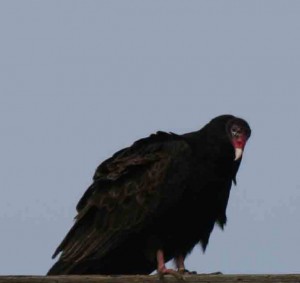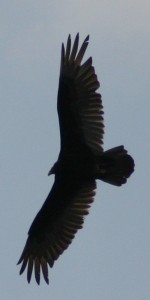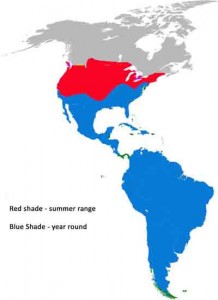General: The Turkey Vulture, the most widespread of the New World Vultures, is found throughout most of the Americas (North and South). In certain areas it is called “buzzard” and “Turkey buzzard”. The Turkey Vulture received its common name from the resemblance of the adult’s bald red head and its dark plumage to that of the male Wild Turkey.1 Its life expectancy in the wild ranges upward of 16 years, with a captive life span of over 30 years being possible.2
Turkey Vultures breed in March and into late spring. Eggs are generally laid in a protected location such as a cliff, a cave, a rock crevice, a burrow, inside a hollow tree, or in a thicket. Clutch Size is typically 1 – 3 eggs that are 2.6” – 3” long and 1.7” – 2.1” wide. The eggs are cream-colored, with brown or lavender spots. Incubation is 38 – 41 days. Chicks fledge between 65 – 90 days.
The Turkey Vulture, like most other vultures, has very few vocalization capabilities. Because it lacks a syrinx, it can only utter hisses and grunts. It usually hisses when it feels threatened. Grunts are commonly heard from hungry young and from adults in their courtship display.
Their sense of smell is incredibly unique in the avian world and they are particularly good at picking up the scent of ethyl mercaptan (a gas produced by animals beginning to decay). The olfactory lobe of a turkey vulture is well developed when compared to other avian species which helps allows a turkey vulture to actually detect odors up to 12 miles away.3
Turkey Vultures hold their wings in a shallow V-shape while soaring and riding thermals.
Identification: Turkey Vultures are large dark birds, 25” long with long, broad wings that measure approximately 72” from tip to tip. The Turkey Vulture’s head is red and unfeathered. The yellowish bill is hooked. The plumage is dark brown except for paler flight feathers, appearing black and gray. They have short, thick legs
Habitat: With its substantial distribution throughout the Americas, the Turkey Vulture is a generalist in its habitat choices and can be found in open and semi-open areas, including subtropical forests, shrub lands, pastures, and deserts. They typically like to stay in areas with open land with nearby areas such as forests for roosting. In the northeastern US, Turkey Vultures can be seen riding thermals over open farmland, the Adirondacks and along lake and ocean shorelines. They are particularly noticeable along roadsides and at landfills.
Territory: Generally, Turkey Vultures can be found from Southern Canada to the southern tip of South America. Certain of its populations do migrate. In upstate New York, Turkey Vultures show up in early Spring and generally leave in early winter. These northern birds may migrate as far south as South America. In the southern United States the Turkey Vulture is a permanent resident.
Diet: The Turkey Vulture is a scavenger and feeds almost exclusively on carrion which can be almost any animal – mammal, reptile, fish, etc. Turkey Vultures almost never attack living prey.
3. http://twcdoc.blogspot.com/2011/10/vehicle-versus-vulture.html


